Varieties of pears, as is known, are divided into winter, autumn and summer. Each category differs not only in terms of ripening, taste, but also in terms of fruit storage.. So, what varieties can be attributed to the winter, and which ripen in summer, see the description below.
Table of contents
Summer pear varieties
August dew
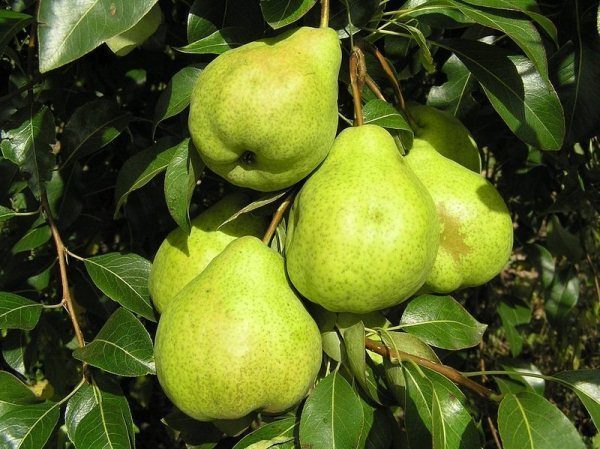
The undoubted favorite among the summer pear varieties is August dew, the result of crossing varieties of Tenderness and Triumph Pakgam. The tree is quite low, does not reach and 10 m tall, the bark is gray, smooth, the kidneys quickly “wake up” after winter. Branches sprawling, slightly drooping, curved. The leaves are oblong in shape, medium size, dark green. Fruits of medium size, ripen in mid-summer. The taste is sweet enough, juicy, with white flesh and delicate skin.
Unfortunately, it is not suitable for long storage, the pear quickly turns brown and disappears. It is itself resistant to diseases and pests, easily tolerates winters, bears fruit every year, increasing the number of fruits. The minus of this variety - constantly needs pruning of the crown, because of this, the fruits become smaller.
Bere Giffard
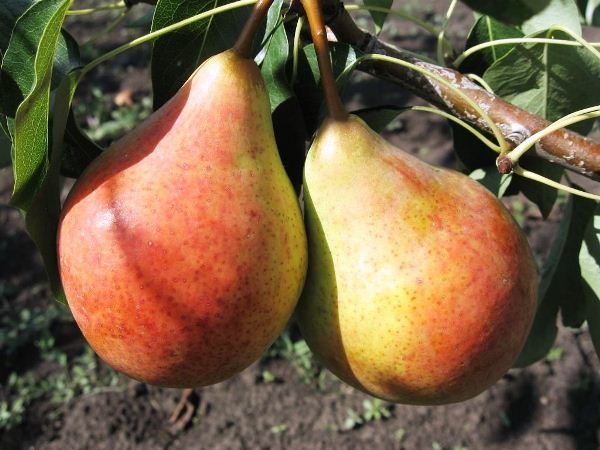
Also applies to summer pear varieties. They differ from other varieties with their “ruddy” fruits, red-orange tones on one side of the pear, and light green shades on the other. Formed on a branch in bunches, from 2 before 6 piecesand keep so until full maturity. Because of the high yield, additional props are often required, otherwise the branches may break under the weight of the fruit.
The fruits are tender, have a sweet taste, juicy, with white flesh. The tree reaches a height of more than 10 m, sparse crown, branches are slightly drooping and thin. Crown brown, flakes off. The leaf plate is dark green, oblong, with smooth edges. The variety does not tolerate harsh winters, therefore, young seedlings require shelter. Fruits are poorly preserved in torn form, not more than a week.
Victoria
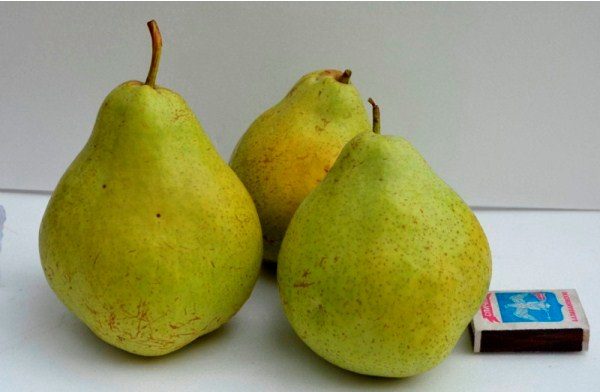
This variety is distinguished by its winter hardiness, is not afraid of drought, and is rarely exposed to diseases and pests. It appeared as a result of the crossing of Bere Bosc and Tolstobozhka varieties. Medium tree, 8-10 m, with a thick crown, has a pyramidal shape of the trunk, the branches are long and thin. The variety is characterized by late vegetation, flowering.Productivity is high, in a year from an adult the tree gathers more than 150 kg of a crop.
The pear begins to ripen in the second half of August, reaching a peak of maturity only by mid-September. Fruits have the correct pear-shaped form, with a smooth and thin skin. The taste of a sweet pear, with juicy pulp, has a pleasant aroma. It is good to make jam and jams from this variety. But a pear is stored for a short time, it does not spoil in torn form for about 3 days, it can hang on a tree for no more than a week, then it falls down.
Duchess
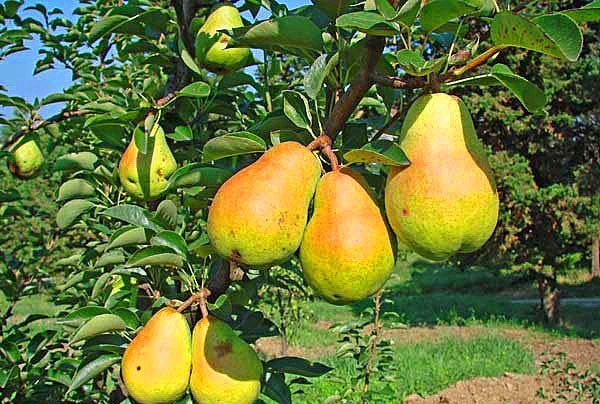
The name of the variety translated as Duchess, was bred by the English breeder in Wheeler. The tree is low, 6-7 m, with a thick crown, branches sprawling, thin. The crown of the tree is light brown in color, smooth.
Fruits begin to ripen in mid-August, the fruits are bright yellow. On average, one pear can weigh more than 150 g, arranged on branches one by one or in groups of 4-6 pears. Stored for up to 40 days in a tree and not more 2 weeks torn. To taste the fruit is juicy, sweet, with a thin skin and a delicate aroma. On the palate there are light notes of nutmeg and spices. The variety is frost-resistant, not afraid of cold weather. It is also not affected by the scab, but the sucker and aphid are on the tree very often.
Northerner
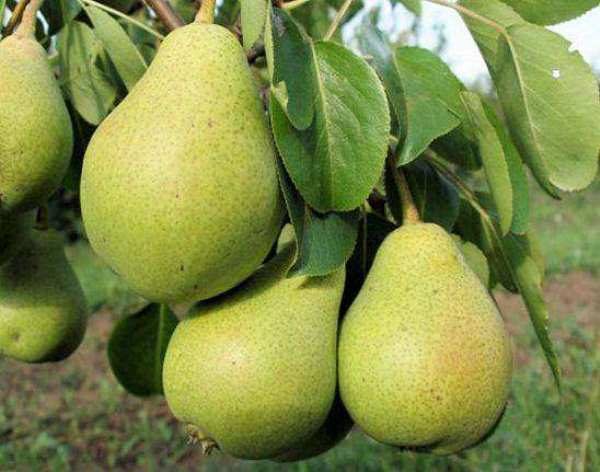
Bred by breeders for the northern regions, hence got its name. The variety is medium tall, tree height from 3 before 6 m, with a thick crown and a pyramidal shape of the trunk. Young seedlings can easily tolerate planting and quickly begin to grow, but the tree begins to bear fruit after 4-5 years. The leaves are a tree of light green color, pointed form, with smooth edges. Blooms in early spring, has more than 6 petals in the inflorescence /
A variety with high yields, fruits strew branches, every year the crop becomes larger, just as the tree bears fruit every year. Pear large to 200 gram each fruit, they are formed into small brushes by 4-6 pears. At the beginning of ripening they have green tones, and then they get yellowish-orange shades. The peel of the fruit loose, it is rather rough. To taste it is not inferior to other varieties, sweet, with juicy pulp, has a sour-tart taste and light aroma. But the seeds in a pear a little, are located in special chambers in the heart of the fruit. It tolerates winters quite well, diseases and pests, does not need special care.
Cathedral
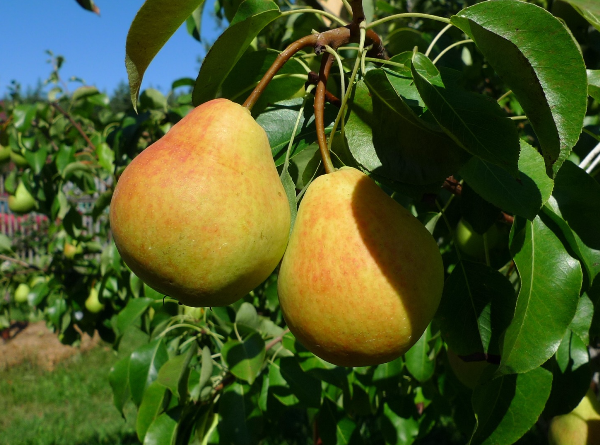
Also applies to summer, skoroplodnymi varieties. Was bred by crossing varieties Forest beauty and Duchess Thigh. Predominantly grows in the Central regions, but due to its resistance to frost, it grows easily in areas of the North. The tree is medium thick, from 4 m tall and taller, with a wide and dense crown, the branches look up. The barrel is smooth, brown-gray. Young shoots slightly wilted, reddish-brown, fruiting occurs on them. The leaves are green tones, smooth, medium size.
Fruiting begins from the 6th year, the pear may exceed 130 grams by weight. Ripening occurs in mid-August, the fruits are stored on the tree for no more than 2 weeks, even less in a torn form. Fruits are lemon-colored, with many inclusions, they change their shades closer from autumn to red-orange, which indicates the full ripening of fruits. The skin is thin, the flesh is cream-colored or white, sweet with a pleasant aroma, medium density. In the middle of the fruit are brown seeds, elongated.
Winter
Saratovka
Obtained by crossing Bere and Bergamot varieties. Above the new variety worked in the Saratov GAU them. Vavilova. Refers to the winter, plucked fruit under the right conditions capable of being stored until February!
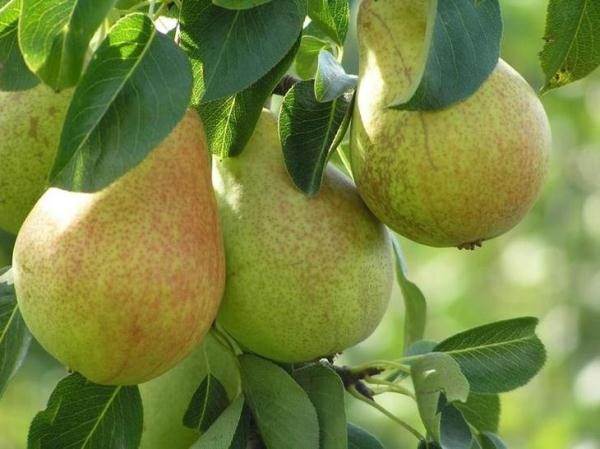
Saratovka variety medium the branches are looking strictly up, the tree is more than 10 m. The krone is dense, a trunk of brown-gray color.Young leaves of light green color, oval in shape, with smooth edges. By the fall they are painted in dark green tones. The disadvantage is a dense crown, which annually needs proper pruning, otherwise, the tree reduces the amount of the crop, gives more strength to the formation of young shoots.
The yield is high, but the tree begins to bear fruit only for 5 year. Fruits are sweet, firm, with a thick skin, lemon-colored, with a red-orange flush. It begins to ripen from mid-August, remains on the tree for a long time, until the end of September. Winter-hardy variety, rarely exposed to diseases and pestsIt also tolerates long-term transportation, does not lose its taste and appearance.
Kondratievka
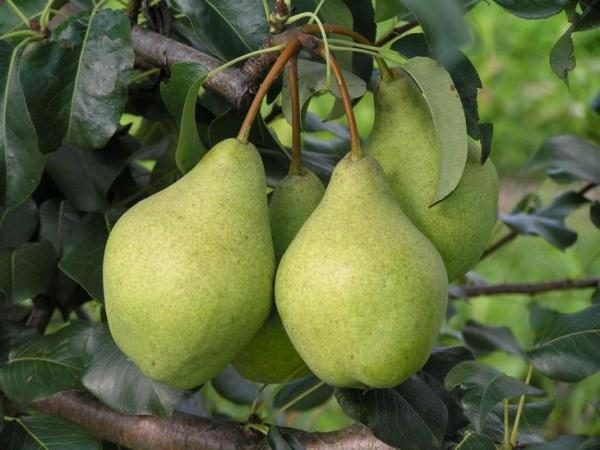
Variety of winter pears, ripening occurs at the beginning and middle of September. High yields start at 5 years after planting. Gives a bountiful harvest annually, the tree does not need rest. The mass of one pear reaches to 230 gram. Fruits are sweet, juicy, with delicate pulp and spicy aroma. Possess the correct pear-shaped form, fasten on a thick curved fruit stem.Possess green when ripe, slightly give in yellowish tones.
The tree itself is quite tall, 10-12 m tall, with a pyramidal trunk shape and slightly lowered branches. The variety is different from the others, by slow growth, mainly it grows green mass. But then gives a large number of fruits. Extremely easy going through severe coldWe are tolerant to various diseases and pests.
Pass Krasan
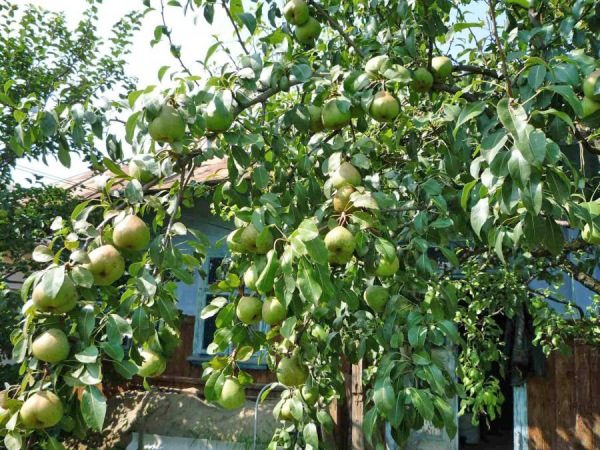
Also applies to winter pear varieties. Unlike other varieties that do not need special conditions, this hybrid requires increased attention. Prefers to grow only in sunny places, does not tolerate close proximity with other seedlings. From the lack of sunlight, its fruits become sour and do not reach the desired size.. He also likes moisture and well-fertilized soil. Extremely badly tolerates cold and is subject to many diseases.
But under all conditions, gives large, juicy fruits with a light sour taste. Fruits annually, does not require rest, but it is not worth waiting for a large amount of harvest from this variety.The weight of one pear can reach more than 200 grams, large pears of light green color. The right time to harvest is mid or late October.By this time, the fruits reach optimal sizes and retain their taste. Plus is the ability of the fruit, will continue until next spring.
May Day
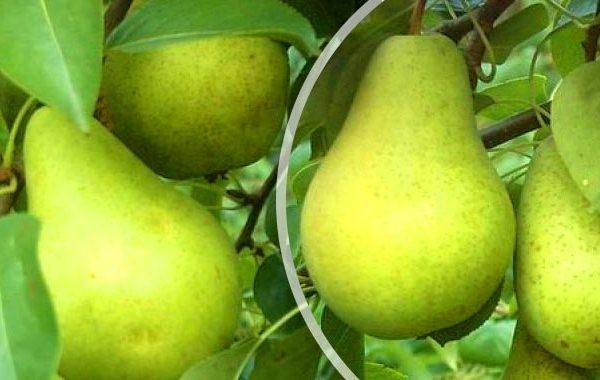
The result of crossing pears Daughter of Dawn and Late. This variety differs from other ones in storage of fruits in a torn form, up to 250 days! The pear is not demanding to care, it is frost-resistant. Rarely sick, overwhelm her many pests. Tree height over 10 m, with a spreading crown. Young shoots rather thin, gray-brown shades, smooth. The leaves are round in shape, with smooth edges, slightly curved upwards.
The average mass of fruits from 140 gram, possess the correct form, a smooth and thin thin skin. During the summer, the fruits of green, closer to the fall, acquire brown-red tones. Mounted on the branches with a strong stalk, form a brush of 4-6 fruits.The taste is sweet, with a pleasant aroma, slightly tart, with white flesh, has an attractive appearance and taste. The variety has high yields, but fruiting begins at 5-6 year.
Lyra
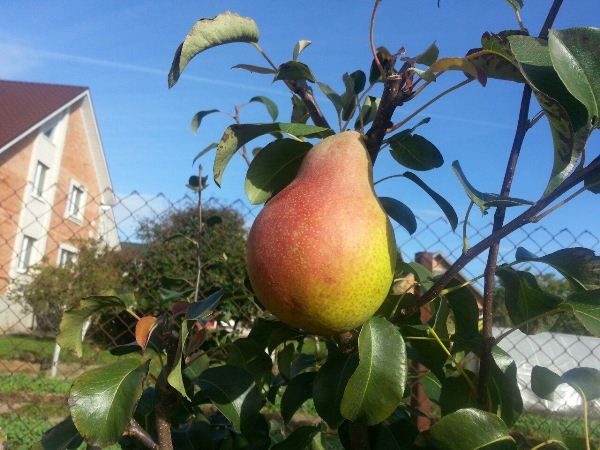
The variety is winter, with a high storage capacity of fruits, up to several months. A tree with a wide pyramidal trunk shape, light brown in color. Branches of medium thickness, often gray, smooth. Leaves elongated, smooth, dark green shades.
More pear mass 200 grams, fruits of greenish tones, acquire a yellowish tint. They have an elongated shape of the fruit, with a smooth and thin skin. Harvesting can begin in September. To taste the pear is sweet, with white juicy pulp. The yield is high, the tree does not need any breaks, but the harvest begins to appear only 4-5 years after planting. Resistant to diseases and pests, but has an average index of winter hardiness. Especially young seedlings need additional shelter for the winter.
Patriotic
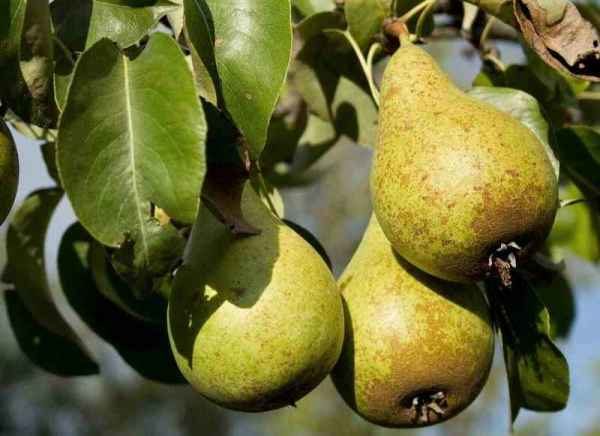
The result of the joint work of O.S. Kharchenko, A.V. Krasovsky and A.F. Mileschko. Blooms in late spring, white rounded flowers with a light scent. The tree itself is taller, more 10 m, with a sprawling crown, straight branches.The barrel is brown in color, smooth, regular shape.
Fruits are large, light green shades, more yellow when fully ripe. Mass of the fetus to 180 gram, has an attractive appearance for sale, also protects the view during long-term transportation. Harvesting from a tree is recommended in early October, the fruits are able to be stored for several months in a cool place. It gives a crop regularly, the tree rarely gets sick and is almost not damaged by insects. It is also frost-resistant and does not need special care, it endures the scab and thermal burns of leaves. Ripe fruits are stored for several months.
Late
Dessert Rossoshanskaya late
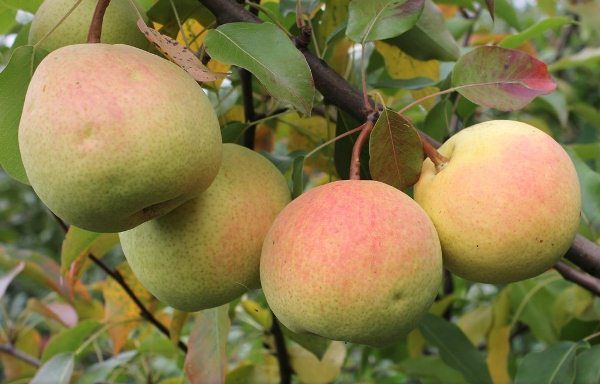
Refers to late varieties, fruit ripening comes at the beginning of September. Dessert pear kept up to January under proper storage conditions.. Hybrid, the result of breeding varieties Clapp's pet and Tonkovetka, launched in 1952. The tree is vigorous, height is more than 6 m, the seedling has a narrow pyramidal shape of the trunk, gray in color, the adult tree forms a wide and smooth trunk. The crown of the pear is branchy, the young branches of gray, look up.
The fruit is quite large, weighing up to 180 gram, dark green tones at the beginning of ripening and brown-red hues to fall. Mounted on the branches of 6 pieces on thick fruit stems. Harvesting begins at 3-4 years, the percentage of yield is high. To taste sweet, with soft skin and juicy pulp.
Belorussian
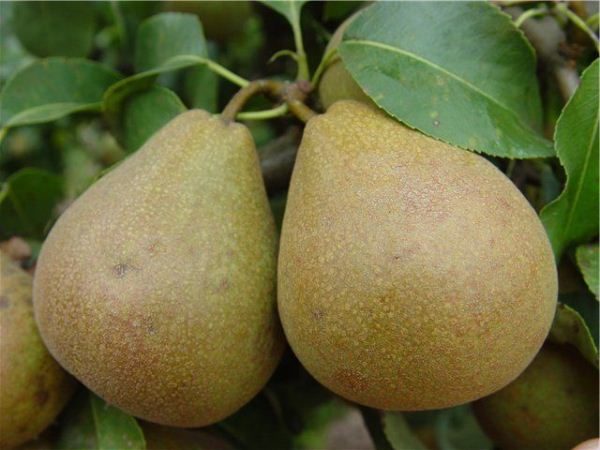
Bred in Belarus. The variety is late, ripening occurs at the beginning of September. The tree is small, no more than a height 3,5 m, branches look strictly up, crown gray-brown, smooth. The leaves are light green tones, oblong in shape, with jagged edges. Flowering occurs at the beginning of spring, the inflorescences are white, with a pleasant aroma.
The fruits are dull, light green tones, changing to orange-red shades during the summer.The pear skin is rough, rather dense, with small black spots. The stem is short, on the branches of pear crowded in pairs. The taste is fleshy flesh with white flesh, juicy, has a slight sourness. Pear hardy, not exposed to pests and diseases. A minus - bears fruit not every year, needs rest.
Olivier de Serre
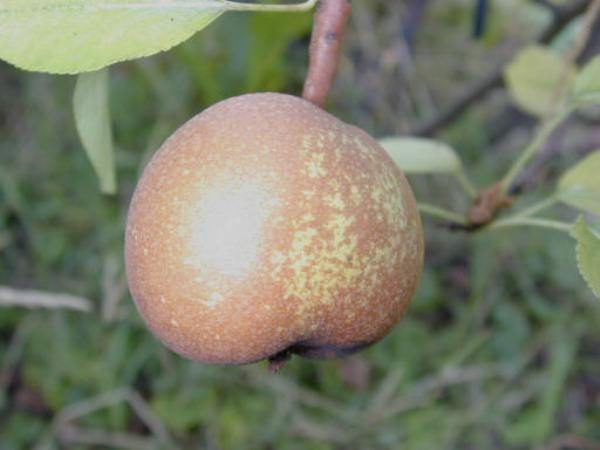
The work of the French breeder. The variety is quite capricious, it requires special conditions for growth and meticulous care. The tree is medium thick, the crown is compact, the branches are directed upwards. Crown brownish, smooth, slightly flaky. During the summer, it forms a lot of new branches, which reduces the yield, so it is important in the fall to remove excess branches. The leaves are shiny, dark green color, rounded shape.
Fruits may exceed 400 gram. In appearance, the fruit is small, round shape, with thick skin. The whole fruit is covered with spots of red color, the surface is uneven, uneven.The pear is sweet, with white fleshy pulp and light pleasant aroma. Pear ripens by September and stored assembled until spring. It is resistant to diseases, but in severe winters it needs additional shelter, otherwise the amount of the harvest in the next year decreases.
Bere Ardanpon
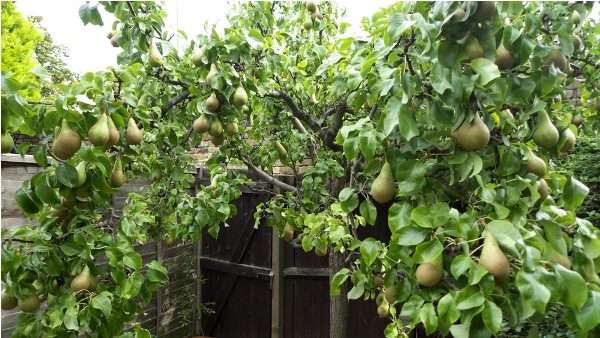
It was bred in Belgium by N. Ardanponom in 1759. This winter-hardy, undersized hybrid requires special care. It prefers to grow in the sun, heat and well-moistened soil - only in these conditions does the tree bear fruit. The tree is vigorous, with a thick crown brownish gray. Young branches are thin, not omitted, the sheet plate is pointed, dark green, slightly pointed in shape. Blooms in early spring, white fragrant inflorescences.
Fruits are large, green in the middle of summer and reddish shades when fully ripe closer to autumn. Pear with a thin smooth skin. This variety is loved by gardeners because of its attractive presentation.which persists until the cold. To taste the pear is sweet, with white, fleshy pulp. It tolerates the winter, but it is better to cover young seedlings.
Hera
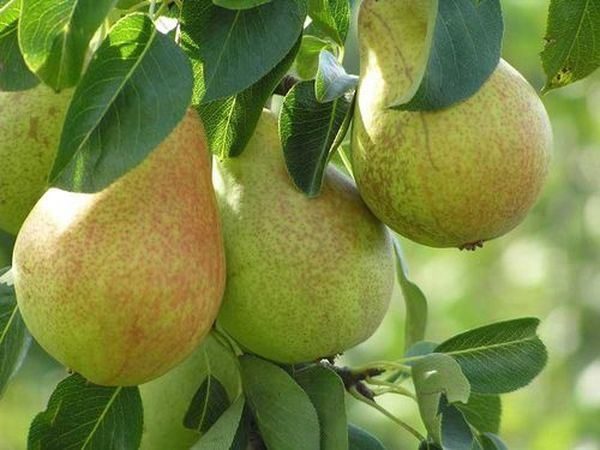
The same applies to winter varieties, which appeared as a result of crossing Real Turin and Daughter Dawn. Especially the variety does not differ from others, but because of its large fruits was fallen in love with gardeners. One pear can have a mass up to 280 gram! In addition, the fruits have light green shades that change to reddish in the process of maturation. Not inferior in taste, pears are sweet, with fine-grained flesh of cream color. Possess gentle, slightly sourish taste, with pleasant aroma.
The tree is medium thick, not more than 6 m high, with spreading branches, crown, brownish in color. Able to produce a large number of crops annually.It is not exacting to conditions and leaving. Plucked fruits are capable of being stored for several months. In addition, the variety is sufficiently resistant to disease, not afraid of insects, frost-resistant.
Wonderful
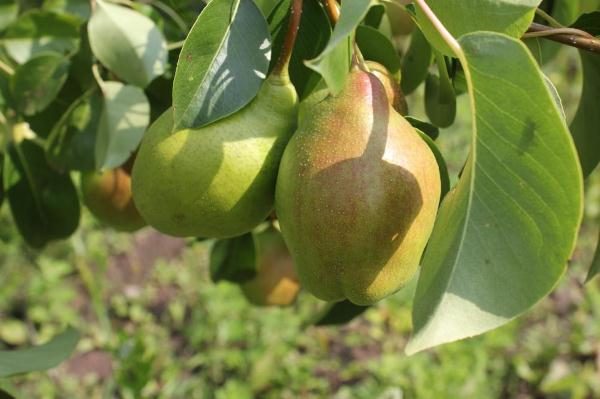
Another winter pear, a hybrid obtained by crossing Daughter of Dawn and Talgar beauty. It has excellent resistance to frost and disease.. It has a pyramidal crown shape, not more than 5 m high. The branches are thin, looking up, gray-brown in color. The leaves are rounded, dark green in color, small light streaks are clearly visible. Blooms in early spring, white fragrant inflorescences.
Variety with high yields, by weight one fruit from 140 before 210 gram, can stay on the tree for a long time and is stored for a long time in assembled form. Fruits of light green color, becoming yellowish, closer to autumn, slightly elongated. To taste sweet, with fleshy pulp, have a delicate pleasant aroma.
Autumn
Autumn garden varieties are different from other long-term storage in assembled form, not inferior in taste to summer or winter.
Veles
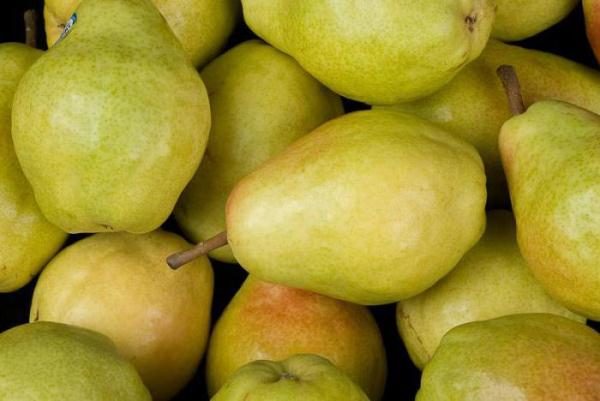
Autumn pears, belongs to one of the best. The fruits are quite large, the average weight of pears from 150 gram and up. Fruits of the correct pear-shaped form: narrow at a stem and rounded from below. On the branches grow in small clusters, 3-4 pears. Pear matures Veles in late August, is preserved on a tree until October. It has a beautiful appearance, until the end of summer the fruits are dark green, and when ripe, they become red-orange tones.The taste properties are sweet, juicy, with fleshy pulp and thin skin.
Tree height not more than 8 mWith drooping branches and a pyramidal trunk shape, gray-brown. Young branches are formed throughout the summer, which affects the amount of the crop, in the fall it is recommended to carry out pruning. Resistant to frost, disease and pests.
Bere Moskovskaya
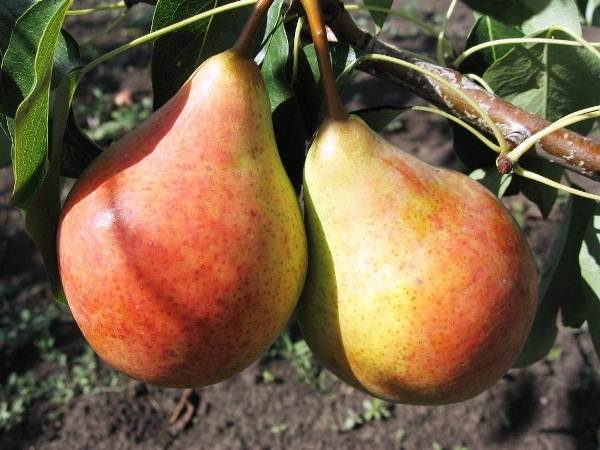
Frost-resistant, almost not exposed to diseases and pests. Appeared as a result of pollination of the Olga variety with pollen from Forest Beauty varieties and Clapp's pet. Tree no more than 6-8 m. The crown of a pear is round, light brown in color. Young branches are quite thin, drooping, gray or brown. The leaf plate is dark green, rounded in shape. Pear blooms in early spring.
Fruits are slightly lumpy, light green shades, there is a light blush closer to autumn.It is better to shoot the fruit slightly green and solid in early autumn.so they are better preserved and lie longer, up to several months in a cool and dark place. If a pear is a bit tart to taste, with a sour taste, it means that the pear lacks moisture.With proper care, the pear becomes sweet and fleshy, with delicate white flesh. In general, this variety is not capricious when leaving.
Red-sided
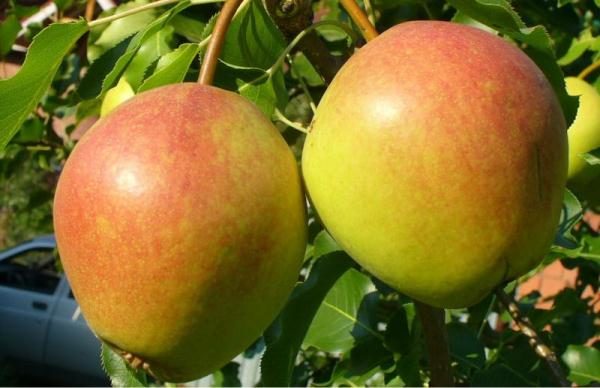
The misconception that this variety refers to winter is not the case, the variety is autumn ripening. Was obtained as a result of crossing varieties Zheltoplodnaya and Tenderness. Resistant to diseases and pests, especially scab. It is frost-resistant, gives a good harvest from year to year. Crohn rounded, branches slightly drooping, brown-gray. The leaves are slightly pointed, light green in spring and dark green tones closer to autumn.
Does not require special care, is able to grow in a small shade, under taller trees, but loves moisture. Fruits of medium size, weight not more than 200 gram. Green pears change their shades to crimson blush to ripen. Sweet to taste, with juicy fine-grained flesh and thin skin. Keep on the branches, on short curved stems. Fruits are able to persist for a long time, both on the tree and assembled, not afraid of transportation.
In memory of Yakovlev
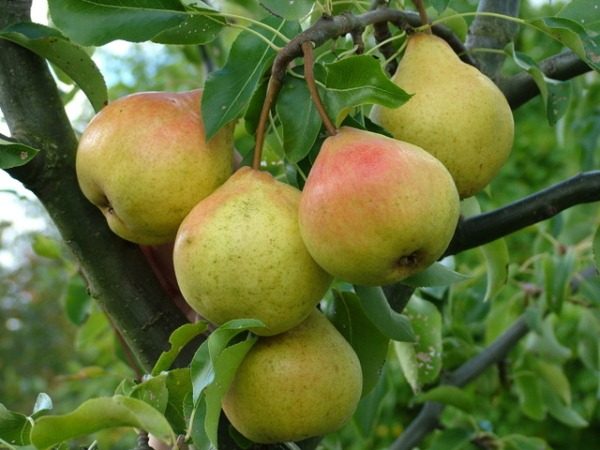
Medium-thick tree with a thick crown.The height of the tree does not exceed 1.5-2m, with a spherical crown. Young branches are thin, looking up, brown-gray in color with small prickles. The leaves are dark green, egg-shaped, with smooth edges. Vintage gives on 6-8 year. Popular variety In memory of Yakovlev in gardeners due to regular fruiting and unpretentious care.
Pears with a smooth and thin skin, weighing no more than 200 grams. The fruits are collected in groups of 5-7 pears. To taste the pear is sweet, with juicy pulp and pleasant aroma. Fruits are golden in color, slightly reddish at the end of ripening. Full ripening occurs in mid-October.. The pear is stored for a long time on the tree, it does not fall off, and in the assembled form it can lie for several months. High yield, which increases with each year of tree growth. More than 30 kg of ripe pear are harvested from an adult tree per year. In addition, it is capable not only of self-pollination, but also pollinates other varieties of pears. Greatly simplifies the care of the pear that it is winter-resistant and unpretentious in the care.
Muscovite
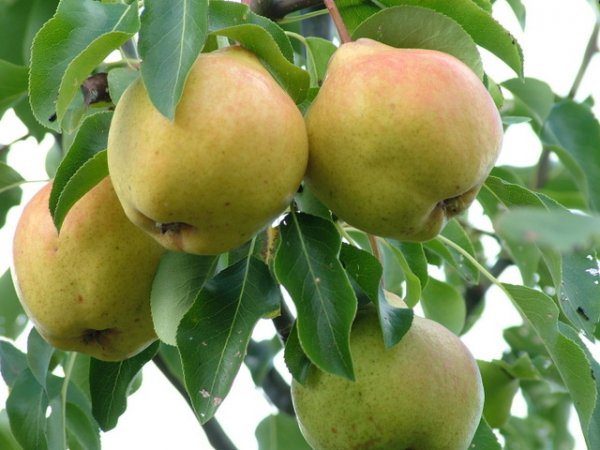
Obtained as a result of pollination of one of the American varieties of pears, Kieffer. Possesses a standard form, with rather dense and sprawling krone, light gray colors, which over time changes shades to brown tones. Quickly forms new curved shoots. The foliage is light green in color, oval-shaped, slightly curved in the center. This variety produces a bountiful harvest in the southwestern regions. The first harvest is formed by 3-4 year.
Fruit Muscovites medium size, up to 150 grams. Possess the correct pear-shaped form. Have a greenish-yellow hue, which is replaced by the end of summer in maroon-crimson tones. The skin is thin, fleshy with juicy flesh with a pronounced sweet-sour taste. It is recommended to pluck pears when they are slightly under-ridden, after lying in the room for a couple of days, the pear ripens and retains its taste. Under the right conditions of storage the fruit can not deteriorate for several months.. High resistance to scab and rot, just not afraid of frost.
Marble
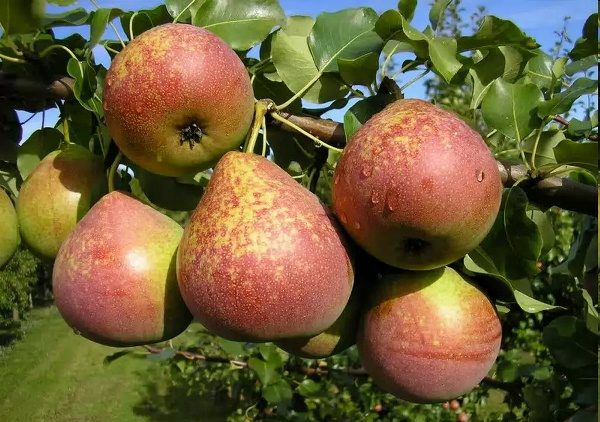
Fruit of crossing of grades Bere winter Michurin and Forest beauty. The crop ripens in this variety to the very beginning of autumn, the first fruits can be plucked in early September. It differs from others in height and thickness of the crown, the height of the tree is more 8 m. A lot of light brown thin branches are formed every year, but the pear shoots are extremely rare. Blooms in early spring white fragrant inflorescences. Foliage dark green color.
Fruits are large, from 170 grams, with yellowish-green shades and a light flush. Pear differs and the correct conical shape of the fruit. The flesh is coarse-grained, tender, juicy. Rather dense skin, with small points of rusty color. Sort Marble, like other autumn pears, frost-resistant, not afraid of diseases and pests. The tree begins to yield only on 5 year, but the percentage of yield is high, the pear is able to please a large number of crops every year.
Pear for the Volga region and central Russia
Chizhovskaya
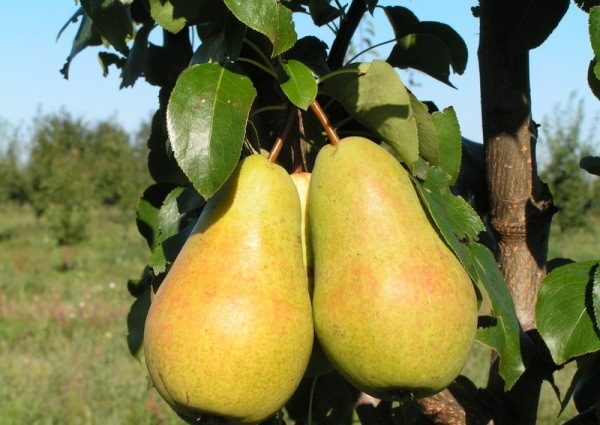
Olga and Forest Beauty were taken as “parental” varieties, as a result of S.T. Chizhov and S.P. Potapov and the variety Chizhovskaya was bred. One of the popular self-pollinated varieties in the middle lane, especially in the Volga region and surrounding areas. The tree stands no more than 3 m, the young tree has a narrow crown, grayish shades. Older branches turn brownish, branches look up, medium in thickness, slightly curved. The leaves are oval-shaped, dark green with smooth edges.
By themselves, fruits weighing no more than 150 grams. At the beginning of summer the pear is of light green tones, the fruit is rather solid, but closer to the autumn they get yellow shades, they become soft. In this state, pear Chizhovskaya will not hang on a tree for a long time, so it is recommended to pluck it at the beginning of autumn. Green fruits can last several weeks.. Sweet and fleshy to taste, ripen in mid-August. They have a white, medium-grained pulp with a pleasant aroma. In addition, inherited from the "native" resistance to frost and disease.
Lada
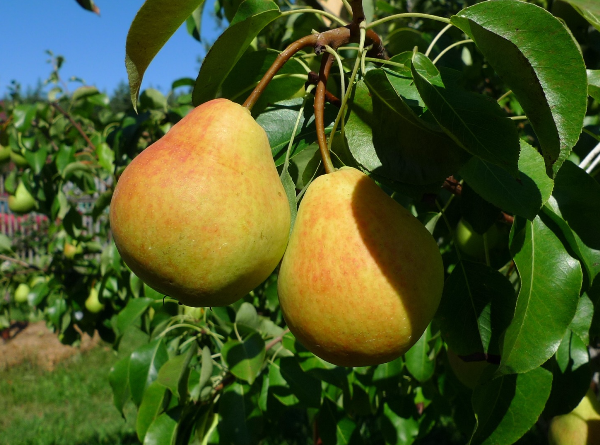
The result of crossing the varieties of Forest Beauty and Olga, a variety suitable for planting in the middle lane. Differs in the ripening of fruits, you can taste fresh fruits in the middle of summer. Lada frost-resistant, not exposed to diseases and pests, annually gives a rich harvest. A tree with a branchy crown, branches slightly drooping, looking down. The height of the tree is not more than 3 m, with a pyramidal trunk, closely gray. The leaves are shiny, smooth, dark green tones.Winters well enough even in the most severe winters, resistant to diseases, partially self-propelled.
Medium sized fruits, no more than 100 gram, light green tones with thin skin. Closer to ripening, the fruits are given in yellow tones, they become soft to the touch. It is important to take a moment to take the fruit from the tree, otherwise they become soft, covered with rusty spots and fall. The fruit is attached to the branches in pairs on short stalks. To taste sweet, with a slight hint of sourness and is stored for a long time in a torn form, especially in a cool place.
Bessemyanka
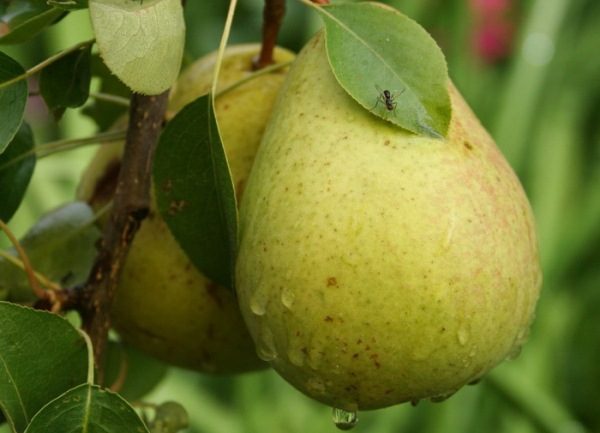
Popular and quite interesting for planting, especially spread in the Central regions, also grows well in the middle lane. The tree is vigorous, the growth rate is fast, consistently yields a crop, does not need rest. Productivity is high, more than a year 50 kg of fruits. Tree height of more than 6 m, with sprawling and curved branches. The leaves are oval-shaped, dark green in color, with rounded edges. It is also resistant to frost, but prone to scab and other diseases.
Annually pleases with a large number of crops, although the fruits are quite small,more like apples. Light green in color, hard when ripe, the fruits turn yellow and soft when ripe. Mounted on branches of one fruit on short stalks. Ripening occurs at the end of summer, when the fruits become yellowish shades. Not long stored on the tree, quickly falls. In addition, it does not last long in a torn form, no more than 2-3 weeks.
Skorospelka from Michurinsk
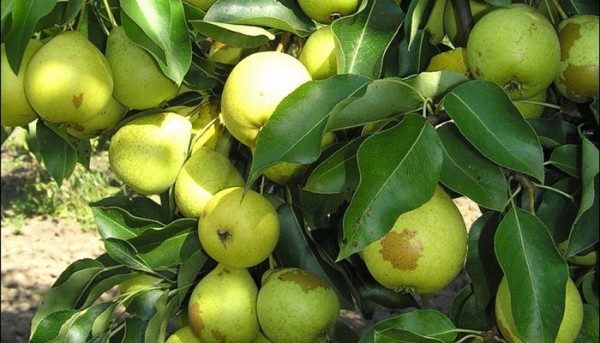
This variety beats all records for fruit ripening speed. Bred IV Michurin, as a result of crossing varieties Citron de Carme and Bere Ligel. Refers to the early varieties of pears, the crop is ripening by the middle of summer. It is a tall tree, the shape of the trunk is pyramidal, light brown in color.
Fruits no more than 90 grams, green in the summer, get a yellow shade at full maturity. Small fruits are compensated by taste: sweet, juicy, this pear is loved not only by gardeners, but by bees and birds. Therefore, it is better to collect them when they are a little solid, stored for no more than a week.The tree itself is winter-hardy, with a thick crown, resistant to diseases and pests.
Allegro
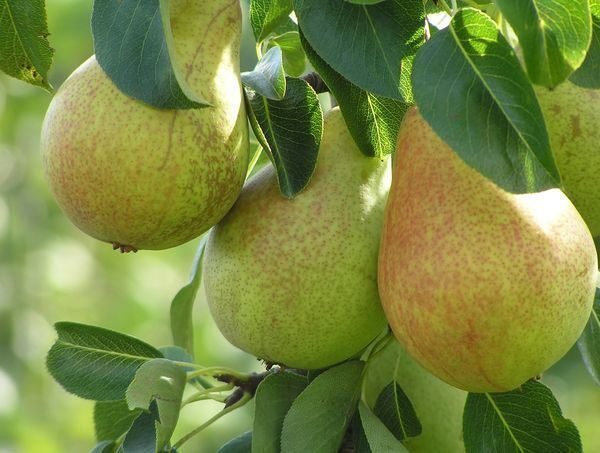
Bred by artificial pollination varieties Autumn Yakovlev. Another variety for the middle band, which bears fruit every year, is unpretentious in care, resistant to diseases and severe cold. Fruiting begins with 3 years, over time, the fruits become larger in size. Tree srednerosloy, more than height 5 mwith a lowered crown. The branches are curved, light gray, the leaves are slightly elongated, closely green in color.
Pear weighing from 120 grams with a thickish skin, but juicy and sweet pulp, with a spicy aroma. The correct pear shape, the fruit is slightly elongated. They are attached to the branches with the help of a thick stalk, growing alone on the branch. Maturation occurs at the beginning of August, fruits turn yellowish-red and soft. The variety is not stored for a long time, ripe fruits hang on the tree for no more than 2 weeks, but when assembled they can last more than a month.
Garden varieties for the Moscow region, description
Prominent or lumpy
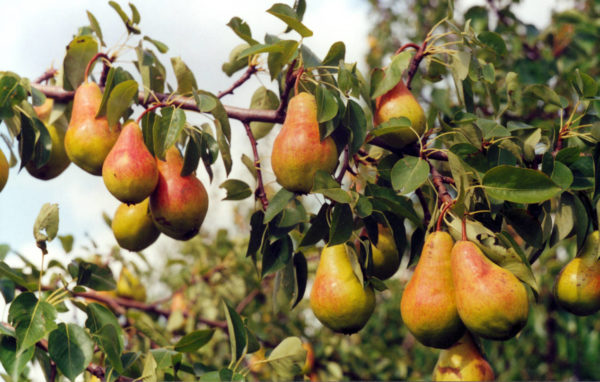
Variety of pears, which has long been loved by Moscow region. Tree no more than 5 m, with a rather sprawling young crown, which subsequently acquires a pyramidal shape. During the summer, the tree forms many young branches that need to be cut in the fall, otherwise the fruit will become shallow. Leaf plate elongated, with light streaks, dark green color. Blooms in early spring, a variety of white inflorescences with a pleasant aroma.
Fruiting begins in the 5th year, the fruits are medium in size, the correct pear-shaped. The color is greenish yellow during the summer, with a red ting closer to autumn. Fruits with thick skin and coarse white flesh. To taste sweet and juicy, with a pleasant aroma. When assembled, it may persist for several months, but it is recommended to collect the fruits in mid-August,when the fruit is sufficiently firm and somewhat under-ripened.
Tenderness
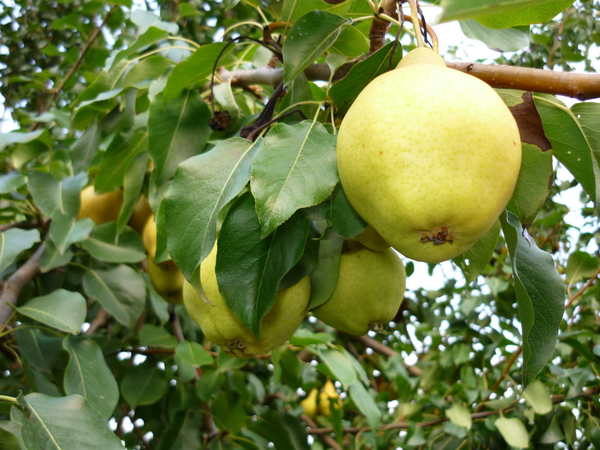
The variety obtained as a result of crossing the Tyoma and Clapp's pet. Especially a large amount of the crop gives in the Volga region, the middle lane and in the suburbs. Tree srednerosloy height of not more than 4 m, with a rare crown. The branches are thin, light gray. The tree blooms in the middle of spring, white, small buds. The leaves are rounded, with smooth edges, smooth. It is frost-resistant, capable to bear fruits annually. Prefers to grow in sunny areas, resistant to diseases, not afraid of pests, so the cultivation of this variety will not be very difficult.
Fruits are large, weighing more 200 gram with the correct pear-shaped fruit. The pear tastes soft, juicy, coarse-grained with a pleasant aroma. Fastened to branches with short stalks. In the middle of the fruit is a camera with brown seeds. The fruits of this pear are long preserved both on the tree and assembled, especially at a temperature of 0 degrees.
Fabulous
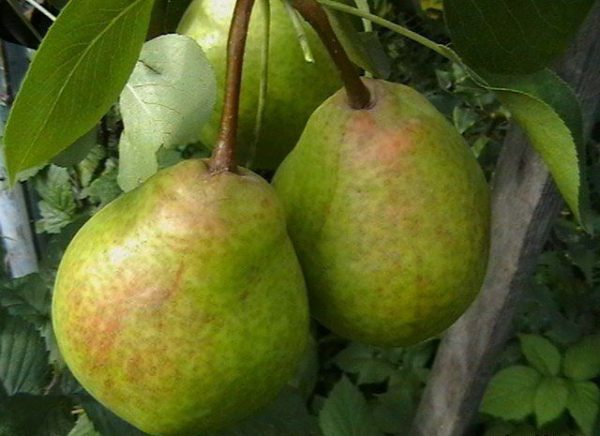
Its name was due to the beautiful fruits. Obtained as a result of crossing varieties of hung and tenderness. Pear has a high amount of harvest from one adult tree is collected over a season more 30 kg of ripe fruit. The height of the tree reaches 4 m, the branches are thick, thin with a gray-brown crown. Sheet plate is smooth, rather small, green shades, with a little bit behind the edges at the edges.
When the pear is ripening, it acquires a yellow-reddish tint on one side and greenish on the other. It has the correct shape of the fruit, besides one pear can weigh more 150 gram. Pulp of pear is white, fleshy, medium-grained. In the center of the fruit - the camera with dark brown seeds. It is resistant to illness, not afraid of frost, seedlings easily take root in a new place.
Vera Yellow

Another suitable variety for planting in the suburbs. Tree over 6 m, with a pyramidal trunk shape, with erect branches of brown-brown color. Young leaves of light-green tones, change color to dark green shades by autumn. It is frost-resistant, does not need special leaving.Pear ripen in mid-September. It differs from the others in that it has a drop in yields, the fruits become shallow, but after a couple of years the pear again pleases with a large crop.
Fruits have green shades throughout the summer, but change their colors to yellow-orange colors closer to autumn. Fastens on short stalks, grows on 2-3 pears in a bunch. The taste is a fragrant and fleshy pear, medium-grained flesh with a thin skin. Good storage capacity, especially in a cool place.
Elegant Efimova
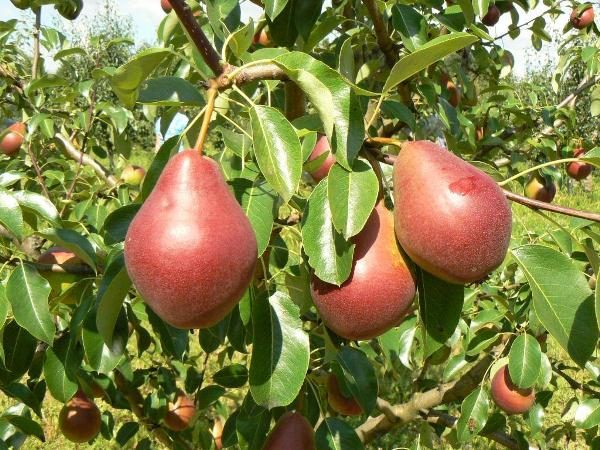
It turned out as a result of the crossing of the varieties Pet Klapp and Tonkovetka. It grows well and gives a rich harvest in the Central region, the Moscow region and other nearby areas. Yield, winter-hardy, not exposed to pests and diseases. The tree is tall, more than 5 m tall, with a thick crown, dark brown color, pyramidal shape. The leaves are small, dark green, with smooth edges.
The beautiful appearance of the fruit, red-orange tones intertwined with green shades. But the fruits are small in size, weighing no more than 120 grams, of a regular, slightly distant shape. Soft, juicy pulp, with a pleasant sweet aroma.The thin skin of a pear is subject to the formation of dark spots during the summer. The fruits ripen in late August, quickly overripetherefore it is better to collect them a little solid, and it is recommended to store them in a cool and dark place.
Venus
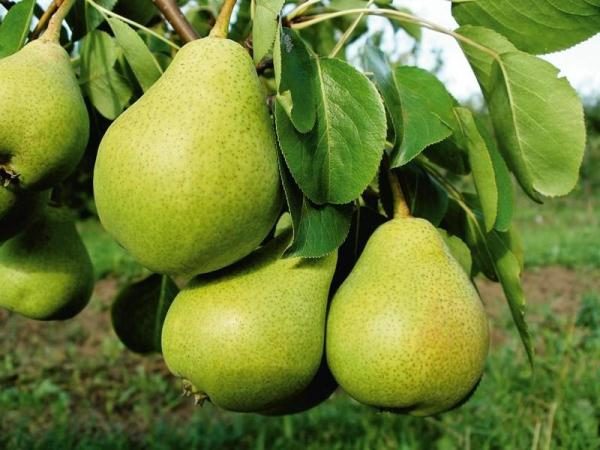
Another popular variety for planting, due to its winter hardiness and unpretentious care. Tree no more 4mThe crown is rather sprawling, the young branches are slightly down, light brown in color. The variety blooms in early spring with white inflorescences with a sweet aroma. Differs variety and high yield, an adult tree over the summer can give more than 40 kg yield. Does not need rest, is able to bear fruit annually. In addition, the variety is quite stable tolerates frost, disease and pests.
The variety ripens in early autumn, the fruits are large, weighing up to 200 gram. The color is red-yellow, when ripe green tones. The taste is soft, juicy, slightly sour with thin skin. Long stored as a tree, and assembled.
Regardless of the specific variety, of which there are a great many today, the main thing in a pear is its taste and useful microelements, which are so numerous in ripe fruit. Winter, summer and autumn varieties differ from each other not only in taste, but also in the speed of fruit ripening., features of care, and the ability to preserve the fruit. Which grade to choose, you decide.
